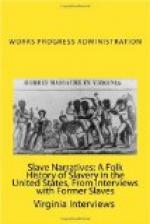“Armarilla, my grandmother came here from Cuba through to Gaines Landing. Her son Edmin and her husband were with her. They crossed the Mississippi River and she said they stopped at the old De Soto camp. A short distance west of this place they met two men—Nick Trammel and John Morrow who profitted (dealt) in Negro slaves. My grandfather and mother employed these men to guide them to Coola Fabre(?) Camden?. From Little River to Dooley’s Ferry these men carried them to Waco, Texas. They killed my grandfather and kept my grandmother forcing her to marry either a half-breed Mexican, an Indian or a Negro. It was near Waco in Hickman[HW:sp.] Prairie that mother was born. The boy Edmin was returned to Dooley’s Ferry and remained in the vicinity until he was about seventeen years of age. He then lived in the vicinity of Little Rock about six months before returning to Mexico. My grandmother said that Mr. Trammel and Mr. Morrow probably thought he might cause trouble and killed him as she never saw him after he returned from Little Rock. Mother was held in Lafayette County at a point where the river crossed and joined Bowie County (Texas) and where Louisiana bounded the south.
“De Soto traveled by land, not by boat. He had a force of about 550 persons. The women dressed as men. My grandmother was with her husband.
“My mother was a slave. She was held in Bowie County, Hickens[HW:sp.] Prairie, by Bob Trammel. They kept her locked up and I have heard mother say that she used whale bone, card bats and a spinning wheel. Finally they got so hot behind the Trammels in 1847-48, they pulled up stakes and went down on the Guadalupe River and carried my mother’s mother down there. Before they left Dave Block went on Trammel’s bond and got my mother. He made my mother head housekeeper slave. She had been taught Spanish. She was tall and fair with straight black hair. She was married to Dick Samuels, my father.
“After the war my father was elected [HW: Hempstead] County Clerk in 1872 on the Republican ticket. He could neither read nor write, so was clerk in name only securing one of the white men to attend to the office. By trade he was a blacksmith.”
Interviewer’s Comment
Uncle Bob Samuels is the son of Richard Samuels and Mary. He was a slave of David Block. After freedom he came to Little Rock with a sister and a brother, John. Uncle Bob said he often heard his mother speak of a gold mine. She had a trunk of maps and charts which her mother had given to her. In this was supposed to be the papers regarding De Soto’s legendary gold mine. The trunk had been lost as Uncle Bob has no idea where the gold mine is. He tells the story the same way, never varying a point. He does not claim to remember Indian trails or names.




